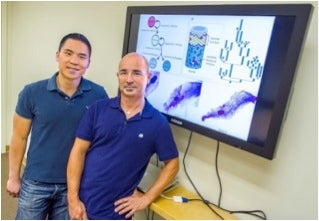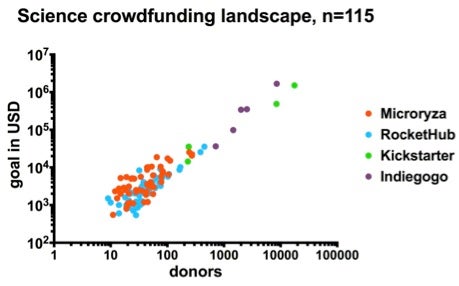- Websites Proliferate for “Reaching out to Engage” for Needed Dollars
- Academics, Universities and Startups are Now Crowdfunding
- Some Projects Attract Big Buck But Most Get Little
Wikipedia defines crowdfunding as “the collective effort of individuals who network and pool their money, usually via the internet, to support efforts initiated by other people or organizations.” In the context of science, it’s tempting to think that this is just a trendy way to characterize what has been done for a long time as charitable giving. However, I hope the following will convince you that crowdfunding is quite different and offers a number of unique advantages.
Faced with research goals that, for various reasons, are not fundable by traditional mechanisms, researchers are turning to crowdfunding to get the dollars they need. “Scientists are beginning to use crowdfunding to support their work, but don’t stop filling out those grant applications just yet”—this according to Jessica Marshall writing in the venerable Proceedings of the National Academy of Sciences.
While crowdfunding is a generic process (in the present context it involves asking members of the public to chip in money for projects that interest them), a number of crowdfunding web sites now offer researchers a page to pitch their idea, typically including a short video whereby potential donors can “meet” would-be recipients. Importantly, crowdfunding is also being used to raise money for startup companies in lieu of traditional venture capital (VC) financing.
 Crowdfunding research through Web-based social media bypasses traditional grant reviews by peers or other experts (taken from conteudoegeek.blogspot.com via Bing Images).
Crowdfunding research through Web-based social media bypasses traditional grant reviews by peers or other experts (taken from conteudoegeek.blogspot.com via Bing Images).
Intrigued by this radical trend in internet-enabled, social media-catalyzed funding of scientific research, I did some homework. In this post I’ll touch on some similarities and differences among the main crowdfunding websites, explore a few representative “case studies”, and touch on some concerns that have been expressed thus far.
Crowdfunding Websites for Research
Indiegogo (“Fund what matters to you”) is an international crowdfunding site founded in 2008 and headquartered in San Francisco, CA. The site's structure allows users to create a page for their funding campaign, set up an account with PayPal, make a list of "perks" for different levels of investment—think TV fund raisers—then create a social media-based publicity effort. Users promote the projects themselves through Facebook, Twitter and other social media platforms. The site levies a 4% fee for successful campaigns. For campaigns that fail to raise their target amount, users have the option of either refunding all money to their contributors at no charge or keeping all money raised but with a 9% fee. I assume this “penalty” encourages users to keep trying to meet their target.
RocketHub (“The world’s crowdfunding machine”) was launched in 2010, and shares similarities to Kickstarter, which was started a year earlier and focuses on helping “bring creative projects to life.” If the selected funding target is not reached by the deadline, the project leader is still able to keep the collected funds. RocketHub charges 4% of funds collected, plus 4% payment processing fees, if the project is fully funded, and 8% plus 4% payment processing fees if the project does not reach its goal. Seems like another “early withdrawal penalty” feature. SciFund Challenge has recently been founded to leverage RocketHub’s platform for science projects.
Experiment is a U.S. web site dating back to 2012 that works on the “all-or-nothing” funding model: 5% for Experiment and 3% for payment processing, but only if the campaign is successful. If the campaign does not reach the funding goal, no one is charged. In February 2014, the site changed its name from Microryza to Experiment.com. The former name Microryza was inspired by Mycorrhizae, a symbiotic fungi that live in the roots of plants. Unlike Indiegogo, backers of Experiment projects do not get tangible rewards for giving money. However, researchers share the scientific process directly with the backers and become a part of the project—think symbiosis.
Crowdfunding Numbers
Ethan O. Perlstein, who you’ll read about in the next section, posted this plot of total number of donors (x-axis) vs. the total amount raised (y-axis) for 115 science projects across four different crowdfunding platforms—as of October 20, 2013—with the comment “115 science projects have been crowdfunded, but crowdfunding can’t compete with grants — yet.”
He added that Kickstarter claims that over 50,000 projects had been successfully funded to the tune of $836 million, with an increasing “pie slice” going to science projects that traditionally would have been funded almost exclusively by the government. Perlstein then offers the following series of comments that I think are quite interesting—including a provocative “universal fundraising statistic.”
“The majority of these 115 science projects fit the academic profile: professionally trained, university-employed, grant-dependent researchers asking focused research questions. But there are also examples of unconventional projects led by self-taught (aka citizen) scientists, student-led, e.g., iGEM teams, and pedagogical research.
Cumulatively, 115 science projects raised $5,082,028 from 47,958 donors, with two megaprojects comprising over half of these totals. Since the average is thrown off by those whoppers, the median is more useful. The median project goal is $3,029, and the median number of project donors is 39.
The above plot reveals two interesting facts about the distribution of science projects. First, the ratio between dollars and donors is roughly 100-to-1 across three orders of magnitude, from $1,000 goals to $1,000,000 goals. In other words, the average donation for science projects is $100. Technically, the average donation falls within a range of $100-$60 per donor. This range is consistent with non-science projects and is probably a universal fundraising statistic that reflects economic and psychological drivers of charitable giving.
Second, there is a ceiling between $25,000 and $35,000 above which Microryza and RocketHub science projects don’t go, but above which Kickstarter and Indiegogo science projects do boldly go. What’s causing this separation? The answer appears to boil down to incentives, i.e., whether science projects offer products or not. There is also a role for the size and engagement of each crowdfunding platform’s donor community, especially repeat donors. Briefly put: tangible rewards shift the average donation size higher than people might spontaneously donate, and built-in communities on Kickstarter, and to a less extent on Indiegogo, means a larger captive audience.”
Crowdfunding Case Studies
If you’re seriously interested in pursuing crowdfunding for your research—or participating as a contributor to research by others—more information can be found by using keyword (e.g. DNA, genes, etc.) search engines provided at the aforementioned websites. In any case, the following exemplary case studies taken from Jessica Marshall’s PNAS article and elsewhere are intended to provide a sense of scope, scale, and success, or lack thereof.
Crowdfunding Platform: SciFund Challenge
Funding Goal / Raised: $2,000 / $2,048
Project: Soundscape characterization of freshwater lakes
Reward Offered: Sound chart of donor’s name being spoken
Take-home Message: “It was a lot of work for $2,000, I’m not going to lie.”
According to Marshall, while a campaign is live, success hinges on staying engaged, responding to questions and glitches, and continuing to spread the word on social media and among potentially interested networks, including relevant businesses and the press. After the campaign, teams need to update backers on the project and distribute the perks, which can include t-shirts, tokens related to the research, or lab tours for larger donors. “I would recommend that people not do this if their sole purpose is fundraising,” says Kuehne.
So why do it if not for money? “I immediately had this network of people who were aware of the research. People would send me papers and ideas for extending the research, and ideas for data management,” she adds. Also, “I felt like I was this little hub for people who were interested in freshwater, in noise, in data management, in new technologies.” Marshall adds that about one-third of Kuehne’s backers were her friends and family, a similar fraction were people she knew but would not have thought to ask for support, and one-third were strangers.
Crowdfunding Platform: Indiegogo
Funding Goal / Raised: $400,000 / $339,960
Project: Global survey of people’s microbiomes
Reward Offered: Profiles of individuals’ microbiomes
Take-home Message: “One thing that’s been very much a learning process is figuring out ways to make the results accessible to the general public.”
With some projects, connecting with the public is an essential part of the research. The American Gut project, and similar project uBiome, invited backers to donate money and samples from their own microbial populations in exchange for a printout detailing the bacteria in their bodies—a continuing “hot topic” of research that I wrote about here last year. The teams counted on growing public awareness about the importance of the microbiome and people’s innate desire to know more about their own microbiome to drive involvement.
Together, the two projects raised almost $700,000. ‘One curious aspect of this crowdfunding approach is that certain groups—like people who ascribe to caloric restriction, or those interested in following paleolithic diets—have shown strong interest’, says Rob Knight, who is the lead scientist on the American Gut project. Marshall added, “this skews the sample population, but it should allow the researchers to make some interesting comparisons, and they plan to contact participants for follow-up studies.”
uBiome is interested in taking crowdsourcing one step further by allowing backers to submit research questions as the database grows. “We wanted to bring the public in in a bigger way, let them ask questions of the data, and really harness the scientific understanding,” uBiome cofounder Jessica Richman told Marshall.
Crowdfunding Platform: RocketHub
Funding Goal / Raised: $25,000 / $25,460
Project: Interactions of methamphetamine with brain cells
Reward Offered: Model of methamphetamine molecule made with a 3D printer
Take-home Message: “The formula is straightforward: social networks + external media + time and commitment.”
Marshall opines that crowdfunding may be more likely to succeed for a project with broad public appeal. Perlstein’s project capitalized on the popularity of the television program “Breaking Bad”, about a chemistry teacher who starts making methamphetamine. Perlstein and a colleague created a short video explaining the concept and posted it on RocketHub. The scientists offered prizes, including the chance to talk science over beer for people who donated $100 or more. The men quickly raised $25,000 from family, friends and strangers.
This past February, Amy Dockser Marcus reported in The Wall Street Journal that Perlstein plans to use crowdfunding to raise $1.5 million for his research at the eponymous Perlstein Lab, B Corp. But why do this? In a nutshell, Perlstein had earned a Ph.D. in molecular biology from Harvard, spent five years doing postdoctoral research at Princeton and there led a team that published two papers on pharmacology, which all sounds very promising as a springboard to become an independent academic researcher. But he was turned down by 27 universities when he sought a tenure-track position, and decided to instead set up his own lab as a Benefit Corporation (aka B Corp) and raise money through crowdfunding.
Dr. Perlstein's specialty is something he calls "evolutionary pharmacology." He plans to study lysosomal storage diseases in yeast, fish, flies and worms, trying to find drugs that slow or stop the disorders, then test the drug candidates in patient cells collected by researchers. He anticipates making money by licensing or auctioning the findings to drug companies or others that can run trials in humans.
Needless to say, there are probably hundreds of researchers who will be eagerly watching to see if this successfully plays out.
Crowdfunding in Academia
Universities are also exploring how to incorporate crowdfunding into their operations, and view the campaigns as potentially valuable outreach—this according to Jessica Marshall—and quite predictable to me. She adds that The University of California, San Francisco (UCSF), has forged a partnership with Indiegogo that, among other things, allows backers to donate under tax-exempt status. Tuhin Sinha, a UCSF administrator who is coordinating the efforts is quoted by Marshall as saying that “we’re totally in a pilot mode. We’re having mixed reviews with this.”
Taking a different approach is Michael Greenberg, Director of Innovation and Strategic Initiatives for the Office of Research at the University of California, Los Angeles, and the cofounder of ScaleFunder, a company that has developed a crowdfunding platform tailored to universities. ScaleFunder lists UCLA, UCSF, and UCSC among its clients. Since all sorts of new trends, like the weather, tend to “blow from West to East” it’s likely that Harvard and MIT might also try this route.
According to Greenberg, when universities coordinate crowdfunding campaigns, researchers can access a much larger network of potential backers. The universities can also provide support as the researchers prepare their text and videos, and ensure that no university regulations are breached. “Institutions have the ability not only to bring in major donors but also major corporations,” Greenberg is quoted as saying.
Crowdfunding Startups
Stephanie M. Lee is a San Francisco Chronicle staff writer who entitled her February 15th 2014 story “Biotech startup turns to crowdfunding,” from which I’ve taken these selected excerpts.
“When Exogen Biotechnology needed to raise money, the startup turned not to venture capitalists but to crowdfunding site Indiegogo. In just 10 days this year, nearly 300 donors from all over the world chipped in $50,000.

The two biophysicists at Lawrence Berkeley National Laboratory are developing a technology that measures DNA damage, which could determine if a person might develop cancer, neurodegenerative disorders and immunological diseases.
‘If you find you have a high level of DNA damage, you can try to find out what's causing it to reduce it,’ Tang said.
At a time when venture capital firms are investing fewer dollars in young biotech companies, a growing number of entrepreneurial scientists are raising money through online crowdsourcing communities like Indiegogo, Medstartr, VentureHealth, RocketHub and AngelList.
Since the recession in 2008, investors have been increasingly reluctant to pour cash into risky biotech startups that face a long and uncertain road to winning approval from the U.S. Food and Drug Administration. First-time venture deals in biotechnology hit a 17-year low in the first three quarters of 2013, according to a Burrill Report analysis of the U.S. life sciences industry. As a result, startups are looking to alternative sources like angel investors, venture philanthropists and now crowdfunding sites.
‘Early-stage life science is just in poor shape in terms of having a variety of funding sources," said Stephanie Marrus, director of UCSF's Entrepreneurship Center. "Everyone should keep their eyes on (crowdfunding). Looking at the global trends, it's definitely become a source of capital. If it becomes appropriated adaptively to health care, maybe we have a new avenue to go down.’
Exogen's founders say they turned to Indiegogo in part because they want to treat the campaign as a citizen science project. Two preliminary trials with 100 people last year gave the scientists confidence in their idea when they found that the older the subjects were, the higher their level of DNA damage. In addition, four former cancer patients had among the highest levels of DNA damage for their age group.
Donors who chip in $99 or more receive a kit to extract blood samples. The samples are analyzed by Costes, a biophysicist who studies the effects of low-dose radiation on cellular processes, and Tang, a postdoctoral fellow in Costes' lab.
Traditionally, if a scientist wanted to measure the level of a person's DNA damage, they would examine cells in a microscope and manually count the number of DNA breaks. Costes, however, said he has invented a way to automate the task with a machine that can scan and objectively score the damaged DNA.
Exogen plans to allow users to check their scores privately online. To prevent the onset of diseases like cancer, people with high levels of DNA damage could try to modify their diet and exercise or limit exposure to the sun. The founders are careful to note that for now, the company won't dish out medical advice or sequence people's genomes. But the company plans to seek FDA approval for its technology as a diagnostic tool.”
Crowdfunding Concerns and Criticisms
While crowdfunding has proven to be an efficient and effective way to raise funding, there are obvious concerns around fraud and the quality of the research being conducted. I won’t comment on fraud, since this is a concern that is common to any online—or old fashion mail—solicitation. On the other hand, quality of science is an issue peculiar to crowdfunding. After cogitating about various ways to address this concern, I concluded that it’s not easy or practical to deal with given that the vast majority of donors are non-scientists. Perhaps posting “letters of support” from bone fide academics would be an effective way to handle this.
Lee quotes Arthur Caplan, a bioethics professor at New York University's Langone Medical Center, as saying that "you can say anything and everything when you're crowdfunding, so the person donating money has to be vigilant. They could say, 'I'm going to find a cure for your child's brain cancer—if you fund it, I'll do it."
Erika Check Hayden, writing in Nature this past February, said that a crowd-funded HIV vaccine project called the Immunity Project has sparked debate, as scientists question the tactics for the public campaign for this project. "It is dreaming big," she quotes co-founder Reid Rubsamen as saying, adding that his enthusiasm makes him an effective pitch man for the Immunity Project, based in Oakland, CA, which has raised more than $400,000.
But missing from Rubsamen’s promotional campaign are any HIV researchers or data supporting the effort’s scientific strategy. The unorthodox approach raises the question of whether crowdfunding, which tends to be more impressed with technology and marketing than peer-reviewed data, is compatible with medical research. This is an increasingly pertinent issue as scientists appeal to the public to fund more projects aimed at developing therapies.
I’m obviously intrigued by the rising popularity and future potential of crowdfunding. I welcome your thoughts, opinions and comments regarding this topic.










